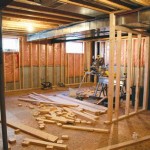How Much Does It Cost To Add A Shower Basement Bathroom?
Adding a bathroom to a basement is a common home improvement project that can significantly increase a property's value and functionality. A basement bathroom with a shower offers convenience, particularly in multi-story homes or when hosting guests. However, the cost of such a project can vary widely, influenced by several factors including the existing plumbing infrastructure, the size of the space, the quality of materials chosen, and local labor rates. A comprehensive understanding of these cost drivers is essential for homeowners planning a basement bathroom addition.
The overall cost can range from a few thousand dollars for a basic, no-frills installation to upwards of tens of thousands of dollars for a high-end, custom-designed bathroom. This article will delve into the various components that contribute to the total expense of adding a shower basement bathroom, offering a detailed breakdown of potential costs and considerations to help homeowners budget effectively.
Plumbing: The Biggest Cost Driver
Plumbing constitutes one of the most significant expenses when adding a bathroom to a basement, particularly if existing plumbing lines are not readily accessible. Connecting the new bathroom to the main water supply and sewer lines requires careful planning and often involves breaking through concrete floors. This can be a complex and labor-intensive process, directly impacting the overall cost.
If the basement is below the level of the main sewer line, a sewage ejector pump will be necessary. This pump pushes wastewater upwards to the main sewer line, allowing for proper drainage. Sewage ejector pumps can cost between $500 and $1,500 for the unit itself, plus installation, which can add another several hundred dollars. The type of pump needed (horsepower, capacity) will depend on the number of fixtures connected to it – a toilet, sink, and shower all contribute to the overall wastewater volume.
Running new water lines also incurs costs. The type of pipe used (copper, PEX) can influence the price. Copper is a traditional choice but can be more expensive than PEX. PEX (cross-linked polyethylene) is a flexible plastic piping that is generally easier and less expensive to install, though its long-term durability is comparable to copper. The length of the pipe runs and the complexity of the connections will also contribute to the overall plumbing expense.
Permit fees related to plumbing work also need to be factored in. Local building codes typically require permits for plumbing alterations, and these fees can range from a few hundred dollars to several hundred dollars, depending on the municipality. Ignoring permit requirements can lead to fines and potential problems during a future home sale.
Fixtures and Materials: Balancing Budget and Aesthetics
The cost of bathroom fixtures and materials can vary significantly depending on the quality and brand chosen. Selecting fixtures represents a critical decision point in the budgeting process. A basic toilet can cost several hundred dollars, while a high-end, designer toilet with features like dual flushing and heated seats can easily exceed a thousand dollars. Similarly, a simple vanity with a standard sink can be relatively inexpensive, whereas a custom-built vanity with high-end countertops and faucets can significantly increase the overall project cost.
The shower is another area where costs can fluctuate. A prefabricated shower stall is often the most budget-friendly option, typically costing between $500 and $1,500, excluding installation. A custom-tiled shower, on the other hand, can be significantly more expensive due to the cost of tiles, waterproofing materials, and the labor involved in installation. High-end tiles, such as natural stone or mosaic tiles, will further increase the cost. Consider elements like shower doors (glass or framed), showerheads (standard or rainfall), and any built-in shelving or seating.
Flooring is another significant material consideration. Tile is a popular choice for bathroom floors due to its water resistance, but prices vary depending on the type of tile. Ceramic tile is generally the most affordable, while porcelain and natural stone tiles are more expensive. Vinyl flooring is another budget-friendly option, offering water resistance and ease of installation. Other flooring options include engineered wood or laminate flooring, but these are less common choices in bathrooms due to their susceptibility to moisture damage. The square footage of the bathroom will directly impact the amount of flooring material needed, and consequently, the overall cost.
Lighting is also a factor to consider. Adequate lighting is essential in a basement bathroom, and the cost will depend on the type and number of fixtures chosen. Recessed lighting is a common choice, providing even illumination. Vanity lighting, such as sconces or light bars, enhances visibility for grooming tasks. Consider energy-efficient LED lighting to reduce energy consumption and prolong the lifespan of the bulbs. The cost of electrical wiring and installation should also be factored in.
Finally, consider other materials such as paint, drywall, trim, and accessories (towel bars, toilet paper holders, mirrors). These may seem like minor expenses individually, but they can add up to a significant portion of the overall material cost. Choosing quality materials that are durable and water-resistant is crucial, particularly in a basement environment which is prone to moisture.
Labor Costs: Hiring Professionals vs. DIY
Labor costs represent a substantial portion of the total cost of adding a shower basement bathroom. Hiring licensed and experienced contractors is generally recommended, particularly for plumbing and electrical work, to ensure that the work is done correctly and complies with local building codes. While DIY projects can save money on labor, they are only advisable for homeowners with extensive experience in plumbing, electrical, and construction work. Incorrectly installed plumbing or electrical wiring can lead to serious safety hazards and costly repairs.
The cost of labor will vary depending on the geographical location, the complexity of the project, and the experience of the contractors. Plumbers typically charge an hourly rate, with rates varying based on experience and skill level. Electricians also charge an hourly rate, and the cost will depend on the amount of wiring required and the complexity of the electrical connections. General contractors often charge a percentage of the total project cost, typically ranging from 10% to 20%. A general contractor can manage the entire project, coordinating the various trades and ensuring that the project is completed on time and within budget.
Obtaining multiple quotes from different contractors is essential to ensure that you are getting a fair price. It is important to thoroughly vet potential contractors, checking their licenses, insurance, and references. A detailed written contract is crucial, outlining the scope of work, the payment schedule, and the timeline for completion. Ensure that the contract includes provisions for change orders, in case unexpected issues arise during the project.
If hiring individual tradespeople (plumbers, electricians, tile installers) rather than a general contractor, you will be responsible for coordinating the work schedule and ensuring that each trade is completed in the correct order. This requires significant time and organizational skills. While it can potentially save money, it also carries the risk of delays and miscommunication.
Beyond the core trades, you may need to budget for demolition, framing, drywall, and painting. Demolition costs can vary depending on the amount of existing structures that need to be removed. Framing involves building the walls of the bathroom, and drywall is used to create the wall surfaces. Painters will apply primer and paint to the walls and trim. Each of these tradespeople will charge accordingly, impacting the overall labor cost.
In summary, the decision to hire professionals versus tackling the project as a DIY endeavor requires careful consideration. It is crucial to honestly assess your skills and experience, and to weigh the potential cost savings against the risks of making mistakes that could lead to costly repairs or safety hazards. For complex tasks like plumbing and electrical work, hiring licensed professionals is generally the safest and most prudent approach.

Cost To Add A Basement Bathroom Bright Green Door

Cost To Add A Basement Bathroom Bright Green Door

How Much Does It Cost To Add A Bathroom In The Basement

How Much Does It Cost To Add A Bathroom 2024 Data

Cost To Add A Bathroom 2024 Guide Forbes Home

Basement Bathroom Cost These 5 Items Will Determine Your

Cost To Add A Basement Bathroom Bright Green Door

Adding A Bathroom To Basement Pros Cons Costs

Cost To Add A Basement Bathroom Bright Green Door

How To Install A Basement Bathroom 2024 Quick Guide
Related Posts







